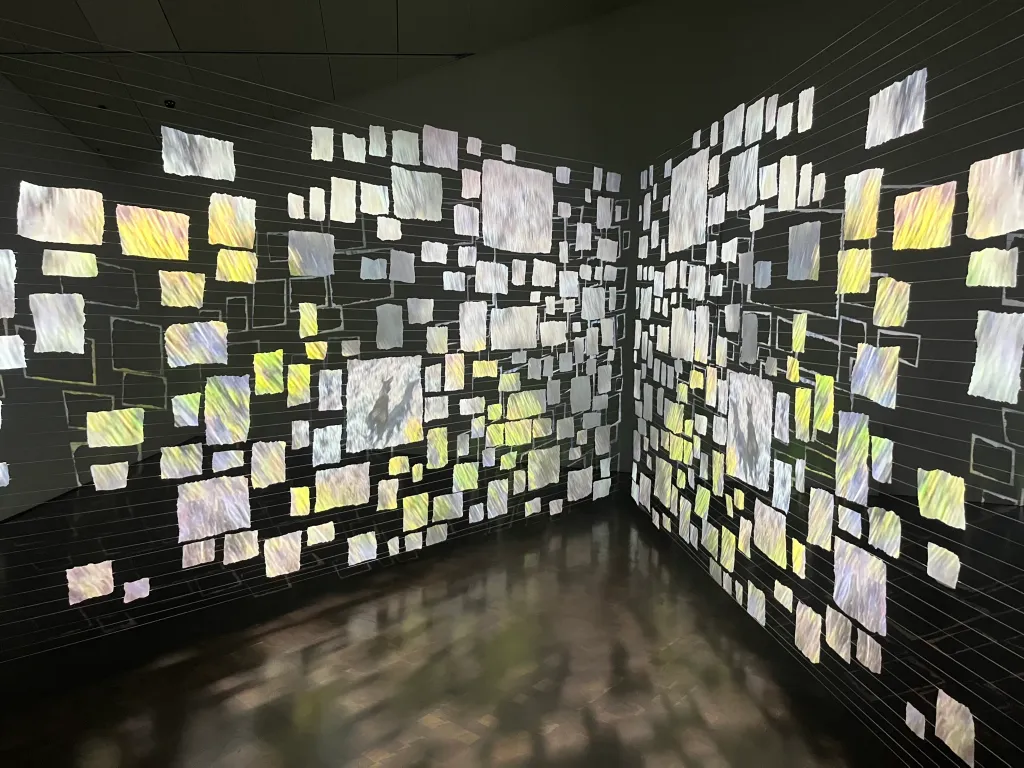
The Denver Art Museum’s recent installation of Sarah Sze’s “Sleepers” is good news in two ways that might matter to art fans. First, it exhibits a fresh work, recently added to the collection, by a widely admired American artist whose busy, buzzy multi-media objects have been a hit for more than two decades. The piece was made in 2024, and DAM has made quick work of getting it on display.
Second, and more lasting, it marks the return of Fuse Box, the museum’s project space for new media works. DAM’s own list of the programming possibilities shows how broad — and on trend with some of the most important 21st-century art-making — this space is, exhibiting “film, video, sound, animation and computer programming, including gaming, internet art, virtual reality, augmented reality, mixed reality, machine learning and other nascent technologies.”
Paintings may still be popular, but they are rarely new. Technology is leading the way, and many young artists who grew up with the stuff and are not afraid to experiment with it are reshaping ideas about what art can be.
One of the most popular examples is video games. Even a decade ago, almost no one saw that genre as a format for serious artistic expression. Now, it is common to encounter game-inspired work in museums and galleries. Often it is interactive, and visitors pick up a controller and have a go at whatever the game’s objective might be.
The AI revolution will only expand the possibilities — and museums need to stay ahead.
DAM was doing that for more than a decade through Fuse Box, which was long-nestled in a dark and quiet corner room of the Hamilton Building. The project space was always a surprise and often an experiment, and it made DAM a bit hipper than some of its institutional, encyclopedic museum peers.
Nationally-recognized artists showed there, including Lorna Simpson in 2016. In 2020, there was a work by Ana Mendieta, who died in 1985 and whose videos and photography were having a resurgence at that time. That was the last Fuse Box show before its disappearance, according to DAM’s online archive.
Notably, the old Fuse Box was also a showcase for local artists who deserved a place in the city’s top institution. Colorado artist Laleh Mehran created a site-specific work in 2012. Photographer Gary Emrich showed in 2011, and so did film and animation artist Stacey Steers. These were important moments in these artists’ careers, and DAM supported them with both space and money.
Fuse Box eventually ran out of steam, and bringing it back was, no doubt, complicated by the many distractions DAM has dealt with over the past few years, including the pandemic and the massive, years-long renovation of the Martin Building. Though now, Rory Padeken, the museum’s curator of modern and contemporary art, has decided to put energy back in Fuse Box’s direction.
“Sleepers” is a nearly-perfect way to reintroduce the space. The six-channel video work is large and approachable, full of big ideas but easy to consume if you give it a minute, because the multitude of video images it projects feature familiar scenes. One minute there is a burning candle, the next a mountainscape, or scenes of people sleeping, or the sun setting in an orange sky. Visually, there are a lot of ways into this piece.
Sze is the kind of artist that other artists — particularly art students — admire, and one reason is that she relies on cheap materials, like paper and her telephone’s camera, to make her work. This object is a good example.
“Sleepers” consists of dozens of tiny screens all made out of simple paper, which has been torn and shaped into squares and rectangles. The screens are connected into irregular grids using a thin string. As the videos are projected onto the paper, the strings seem to vanish, leaving the paper to appear suspended in air. (Suspending things is one of Sze’s trademarks.)
The screens are set up on two wall-sized planes that converge at the back, taking on a V-shape. Viewers see the piece mostly from the open end of the “V,” which has the effect of pulling them into the installation. It’s not an immersive or interactive work, exactly, though it can feel like one.
The images come and go, and come again, rapidly. As soon as your eye makes sense of a scene, it changes. The piece is an exercise in grasping an idea, letting it go, grasping for another.
And, crucially, trying to hold on to the memory of each experience. Like a lot of Sze’s work, it is about how we see things and process memories in a world that offers us so much to consider every day. This exploration of memory is particularly relevant in the current social and technological moment, when we are bombarded with screen-lit images nearly every minute of the day and try to process and hold onto information.
Sze has been making and evolving this work for decades, but it has become more relevant in the current see-and-swipe world of social media, dating apps and online video viewing. A 14-year-old who has been staring at digital objects his entire life and now consumes the world largely through Instagram might find a lot of interest in “Sleepers.”
That said, it’s a work for everyone, though you do need to spend a little time there. The Fuse Box setting makes it easy to settle in. The work is set apart in this darkened room, far from the other glittering objects vying for attention in the museum’s contemporary galleries.
Despite its ultra-modern edge, there is something nostalgic about visiting the Fuse Box, especially for folks who knew and appreciated its earlier incarnation and missed it on museum visits. But it also harks back to a time, starting in the late 20th century, when tech-driven art started appearing in museums, and art-making felt fresh and full of possibility. Who knew back then where art would end up?
Fuse Box brings that feeling back. It’s a landing place, even if temporary, for exciting, cutting-edge work. Can’t wait to see what comes next.
IF YOU GO
“Sleepers” will be on exhibit until July 31, 2026, at the Denver Art Museum. Info: 720-865-5000 or denverartmuseum.org.



